Knowde Enhanced TDS
Identification & Functionality
- Chemical Family
- Ingredient Origin
- Cleaning Ingredients Functions
- Technologies
- Product Families
Features & Benefits
- Labeling Claims
- HII Features
- Performance Benefits
The bacterial strains in this product have been selected for their ability to degrade a wide range of organic matter commonly found to be the sources of odor and soil on hard surfaces, whilst offering the following benefits:
- Probiotics remain on surfaces for up to four weeks after cleaning, helping to remove additional soil whenever it reappears
- Continue to activate in the presence of malodors behind the scenes, neutralizing and reducing odors for longer
- Allow for easier removal of soil when used over multiple cleaning cycles
- Product Highlights
CroBiotic™ 100 provides convenience in cleaning by providing benefits in a range of application areas with a single product, instead of requiring different products for specific applications. Bad odors are often generated over time due to food spillages, cooking activities or pet accidents. Likewise, soil from our daily activities accumulates over time on our household surfaces. Out of habit, we use strong air fresheners to mask the bad odors, solving the problem for a short while, but these bad odors tend to return and are not easily overpowered. We also turn to standard chemical cleaners to remove dirt from our hard surfaces, yet these chemical cleaners often fail to clean down to microscopic levels, whilst carrying the potential to cause damage to our surfaces. Instead of relying on traditional cleaning approaches, consumers can now let nature do the work with CroBiotic™ 100.
Applications & Uses
- Markets
- Applications
- Home Care Applications
- I&I Cleaning Applications
- Applications
CroBiotic™ 100 can be used in a range of application areas:
- Toilets
- Sinks
- Floors
- Carpet and fabric care
- Waste bins and refuse collection area
- Pet stains and animal bedding
- Spoiled food, fish, cigarette smoke, other odorous compounds
- Vehicle interiors
- Countertops
- Formulating with CroBiotic™ 100
CroBiotic™ 100 has broad compatibility with non-ionic, anionic and cationic surfactants, including Croda’s 100% bio-based ECO range that offers additional sustainability benefits.
Target compounds Wide range of malodorous organic compounds including amines, sulfides/mercaptans, and volatile fatty acids. This product also targets the degradation of proteins, starches, cellulose and fats/oils
Appearance Tan powder Bacterial type Bacillus spore blend
Bacterial count Concentrate (as supplied): 1e11 cfu/g 0.1% inclusion for 1e8 cfu/ml in a formulation
Formulation examples- Easy clean probiotic dilutable bathroom tablet with CroBiotic™ 100 - HCHS127
- Green general purpose probiotic dilutable tablet with CroBiotic™ 100 - HCHS128
- Easy clean probiotic dilutable kitchen tablet with CroBiotic™ 100 - HCHS129
- Green all-purpose probiotic dilutable odor neutraliser tablet with CroBiotic™ 100 - HCHS130
* Zinador™ was developed and produced with Itaconix polymer technology.
Properties
- Physical Form
Regulatory & Compliance
- Certifications & Compliance
Technical Details & Test Data
- How do probiotic cleaners work?
The flow chart below demonstrates the working mechanism of CroBiotic™ 100. Spores germinate on the surface where they begin to produce enzymes that degrade soil molecules. This allows for deep cleaning on hard surfaces over time and malodor removal at the odor source.
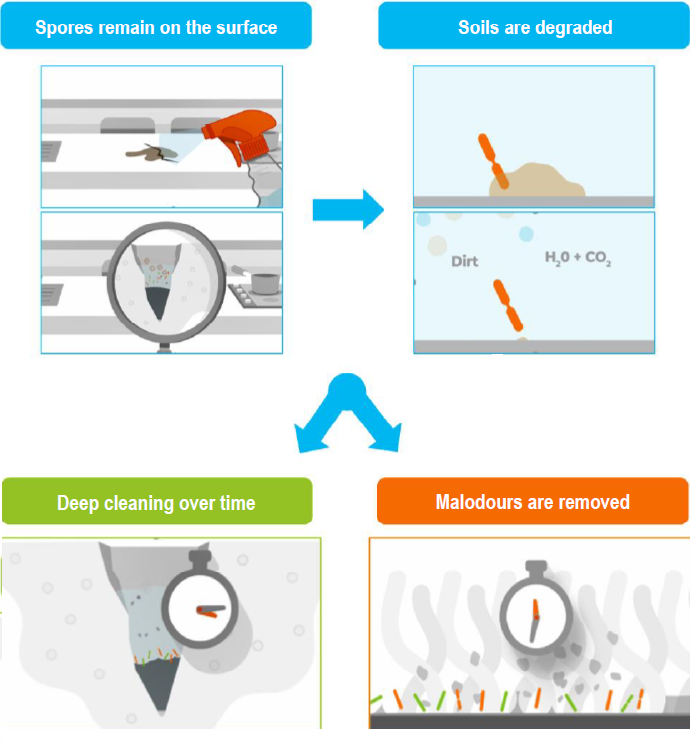
- Spores remain on the surface
- CroBiotic™ 100 probiotic spores remain on surfaces after the initial clean
- The spores germinate and begin producing enzymes
- Soils are degraded
- These enzymes degrade molecules on the surface
- Large, insoluble hard surface soils are broken down
- Sources of malodor are degraded
- Deep cleaning over time
- CroBiotic™ 100 breaks down large molecules into smaller ones which are more easily removed on repeated cleaning
- More soil is removed and a deeper clean is achieved
- Malodors are removed
- Over time, CroBiotic™ 100 degrades malodor molecules
- Existing malodors are removed, and new malodors are prevented at the source
- Spores remain on the surface
- Creating Optimized Probiotic Blend Using CroBiotic™ 100
Figure 1: CroBiotic™ 100 grown on indicator plates displaying the presence of amylase (bottom right), lipase (top right) and protease (left)
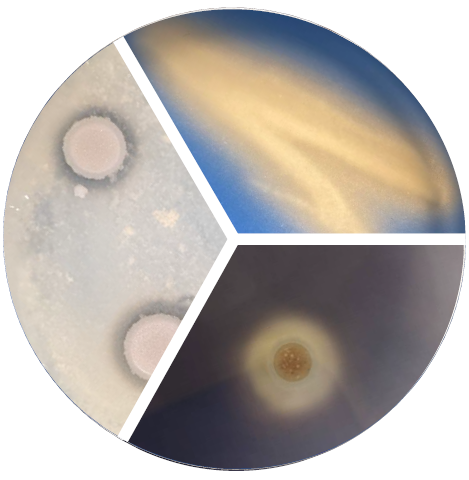
- CroBiotic™ 100 is formulated using a blend of probiotic strains selected specifically for their ability to break down molecules which contribute to hard surface soils and malodors around the home. To demonstrate how CroBiotic™ 100 can produce different enzymes in the presence of different nutrient types, enzyme indicator plates were used, shown in Figure 1. In these tests, 10 μl of inoculum was pipetted or spread onto agar plates infused with either casein (protein), starch (carbohydrate) or tributyrin (fat) nutrient sources. The plates were then incubated overnight at 37°C. As CroBiotic™ 100 grows on the agar, it produces different enzymes to break down the different nutrient sources.
- Degradation of the nutrients can be seen in a clearing zone around the inoculum. For example, to the bottom right of Figure 1, an iodine indicator which turns black in the presence of starch was used to highlight the presence of the carbohydrate. Whilst the majority of the plate turns dark, a clear zone around the inoculum can be seen, indicating absence of starch in this area as CroBiotic™ 100 has degraded the starch molecules.
- Selecting a probiotic consortium capable of producing a range of enzymes, and so being able to degrade a wide range of nutrient types, allows CroBiotic™ 100 to degrade different soil types around the home, across a wide range of applications.
Long Lasting Activation of the CroBiotic™ 100 blendFigure 2: CroBiotic™ 100 viable and culturable spores recovered from treated ceramic tiles with images from first, midway and last timepoints.
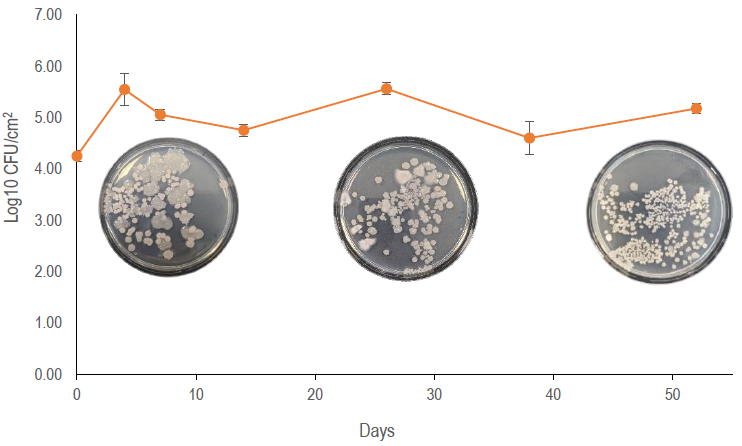
CroBiotic™ 100 was suspended in phosphate buffered saline (PBS) to an inoculum concentration of 6.8x107 cfu/ml. 10μl of the inoculum was added to three separate spots on a ceramic tile. This was then recovered by swabbing with a pre-moistened swab which was then placed into 500μl of PBS in sterile tubes. The tubes were then sonicated for 5 minutes. The resulting suspensions were then diluted and plated out onto tryptic soy agar (TSA) and incubated at 37ºC for 24 hours. Tiles were inoculated for this test and stored at room temperature (21ºC) allowing recoveries to be taken regularly for 52 days. The results show that CroBiotic™ 100 remains viable and culturable long after being applied to surfaces. The spores can germinate in the presence of nutrients, providing long term cleaning benefits shown in the flow chart above. Recoveries were compared using an ANOVA test, no significant difference was observed when day 7 was compared to day 52. The images present were taken from first, midway and last recoveries. Images were taken of TSA plates inoculated with 100μl of recovered solution from 4, 26 and 52 day timepoints.
- CroBiotic™ 100 for Odor Neutralization
Neutralizing and reducing odors for longer
- The combination of wide spectrum soil degradation and long lasting activation allows CroBiotic™ 100 to provide a long term odor control solution around the home, both removing odors at the source and preventing odors from build up on surfaces. To demonstrate these benefits, different studies were carried out using a range of malodors from across the home (pet odor, sweat, kitchen and dirty laundry), applied to a range of fabric types (cotton, polyester and Lycra). The evaluation methods for the different studies are shown in Figure 3.
- To evaluate odor removal, fabrics were impregnated with the different malodors for 24 hours. The fabrics were then treated with test formulations containing combinations of ECO NatraSense 265™ (a nonionic surfactant), CroBiotic™ 100 and Zinador™ 35L*, our bio-based odor neutraliser. The treated fabrics were then evaluated by an expert panel at intervals over a 48 hour period to demonstrate the long term odor control benefits that CroBiotic™ 100 provides.
- To evaluate odor prevention, fabrics were treated with the test formulations before odor impregnation. The expert panel then evaluated odor build up on the treated fabrics to demonstrate how CroBiotic™ 100 can activate and break down malodors as they appear on the surface.
Figure 3: odor removal and prevention methods using an expert panel to evaluate long term odor control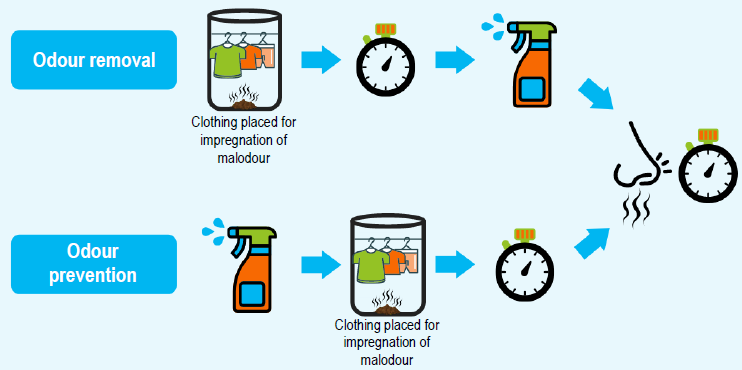
Pet odor neutralization on cotton over 48 hours after treatment with CroBiotic™ 100- Figure 4 demonstrates how CroBiotic™ 100 degrades malodors at the source to effectively remove and neutralize malodors over time. Cotton fabric impregnated with pet odor (cat urine and dirty dog) was treated with cleaning formulations containing combinations of surfactant, CroBiotic™ 100 and Zinador 35L. CroBiotic™ 100 spores germinate on the fabric and produce enzymes which degrade the malodor, evident through a significant reduction in malodor intensity over the 48-hour test.
- The bar chart in Figure 5 focusses on the 48 hour time point of this test to evaluate the overall benefit of using CroBiotic™ 100 for odor removal. The results show that addition of only 0.1% CroBiotic™ 100 to the formulation resulted in a 4x higher odor neutralization compared to the surfactant only control. Performance can be boosted further by combining CroBiotic™ 100 with Zinador 35L.
Figure 4: The effectiveness of CroBiotic™ 100 and Zinador 35L when neutralizing pet odors on cotton fabric over a 48 hr time period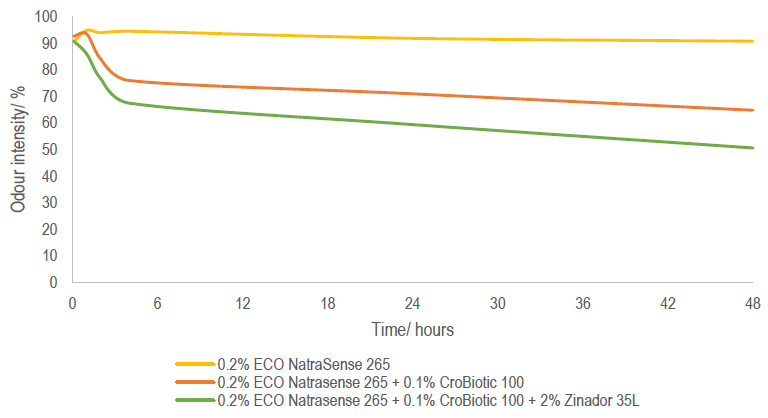
odor neutralization of pet odor on cotton 48 hours after treatment with CroBiotic™ 100Figure 5: The effectiveness of CroBiotic™ 100 and Zinador 35L when neutralizing pet odors on cotton fabric after a 48 hour time period. The error bars represent +/- standard error. (***) p<0.001, (**) p<0.01.
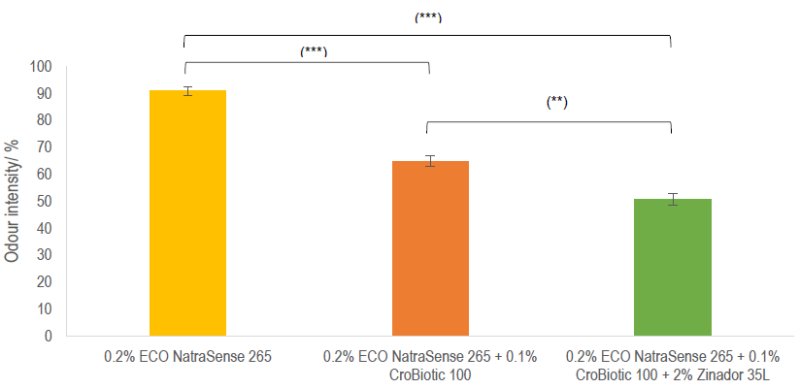
To demonstrate the odor neutralization effect from CroBiotic™ 100 and Zinador 35L on different fabrics, a series of tests were carried out to measure the neutralization of various odor types on three fabrics - cotton, polyester and Lycra. The same test method was carried out on a range of household odors.
Neutralization of household odors 48 hours after treatment with CroBiotic™ 100Figure 6: The effectiveness of CroBiotic™ 100 in reducing the odor intensity of various household odors. The error bars represent +/- standard error. (***) p<0.001, (**) p<0.01, (*) p<0.05, (n.s.) not significant. Results show average result for each malodor across cotton, polyester and Lycra fabrics.
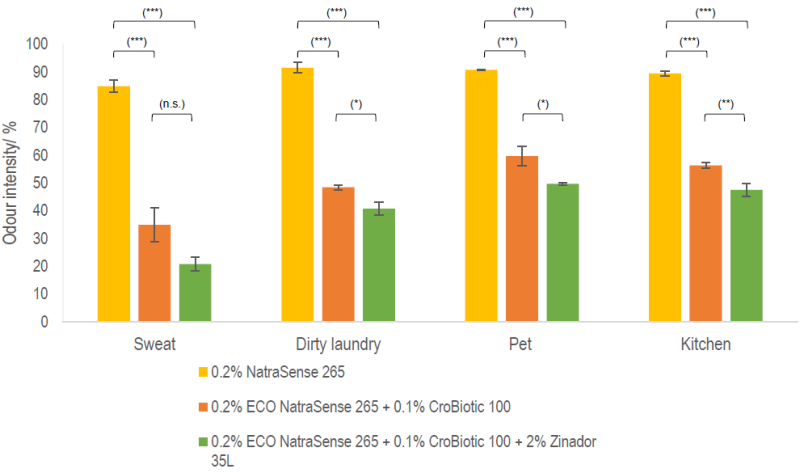
The average neutralization of odor across the three fabrics can be seen in Figure 6, where on average, CroBiotic™ 100 provides 5x higher odor neutralization than the control formulation. CroBiotic™ 100 was found to be most effective at removing various household odors when combined with 2% Zinador 35L and 0.2% ECO NatraSense 265, as indicated by the darker green bars.- CroBiotic™ 100 for Preventing Odor Formation
Build up of sweat odor on polyester over 24 hours after treatment with CroBiotic™ 100
Figure 7: 0.1% CroBiotic™ 100 with 2% Zinador 35L and 0.2% ECO NatraSense 265 reducing sweat odor intensity on Lycra after 5 minutes. The error bars represent +/- standard error.
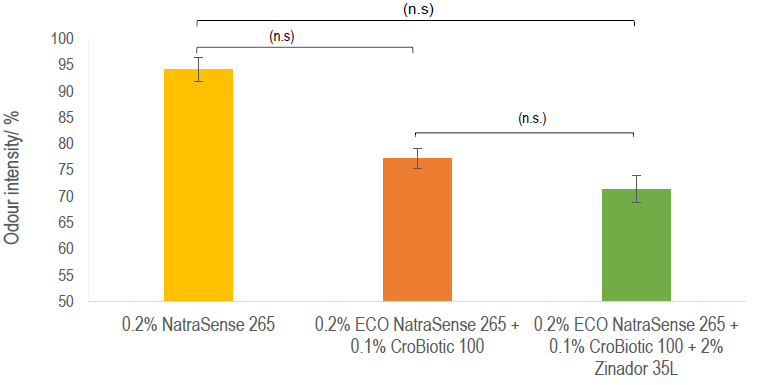
To demonstrate the odor prevention benefits (as opposed to odor neutralization), CroBiotic™ 100 was applied to fabrics first, prior to malodor exposure. odor evaluations were then carried out following a 24 hour odor impregnation period. Figure 7 shows odor intensity 24 hours after malodor absorption. Results indicate that the control had no effect on reducing odor intensity, yet CroBiotic™ 100 provides 4x better reduction in odor build up compared to the control. This result demonstrates the odor prevention mechanism of CroBiotic™ 100. From a consumer perspective, the addition of CroBiotic™ 100 allows for the wear cycle of clothing to be extended, reducing malodors building up during wear and ultimately allowing clothes to be washed less.Neutralization of sweat odor on polyester over 48 hours after preventative treatment with CroBiotic™ 100
Figure 8: 0.1% CroBiotic™ 100 with 2% Zinador 35L and 0.2% ECO NatraSense 265 reducing sweat odor intensity on polyester after 48 hours, demonstrating a longer lasting effect
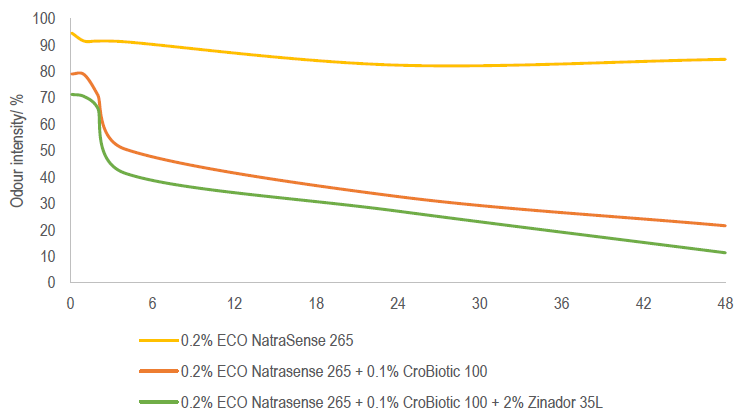
Figure 8 shows what happens to the odor intensity after the next 48 hours of the odor prevention test method mentioned in Figure 3. We can see a lower odor intensity with CroBiotic™ 100 at the beginning of the test due to the prevention mechanism. Then over time, the removal mechanism comes into action, allowing malodor intensity to reduce to 22% with CroBiotic™ 100 alone and 11% with the addition of Zinador 35L, giving 6 times higher odor neutralization than the control. From a consumer perspective, the addition of CroBiotic™ 100 allows clothes to be stored after wear and to be put back on smelling clean again, without the requirement for a wash.The combination of odor prevention and removal benefits of CroBiotic™ 100 in a fabric care treatment could allow consumers to wash their clothing less often. Treating with CroBiotic™ 100 before wear can prevent odors building up on clothes so they smell fresher at the end of the day. Furthermore, the removal benefit means that clothes can be put into storage and taken out fresh, allowing them to be worn again without washing.
- CroBiotic™ 100 for Hard Surface Cleaning
Easier removal of soil
- The ability of CroBiotic™ 100 to break down difficult to remove soils over multiple cleaning cycles was evaluated using melamine tiles treated with fat, protein and carbohydrate rich soils. In the evaluation, 2.5cm test areas were directly treated with 5 evenly distributed drops of cleaning solution. The test areas were then cleaned with a dry paper towel after a 1-minute contact time.
- To measure soil removal, ΔY measurements were taken for each test area using an X-Rite Color i5 Spectrophotometer after samples had been cleaned and allowed to dry overnight under ambient conditions. The ΔY measurements were recorded after up to six cleaning cycles to demonstrate the benefit of continued use of CroBiotic™ 100 over time.
- Figure 9 shows the removal of cheese soil over time using this method. In the early cleaning cycles, both formulations with and without CroBiotic™ 100 show equal performance. Between cleaning cycles, CroBiotic™ 100 spores germinate and degrade the soil, making it easier for the surfactant to remove on the next cycle, leading to a significant improvement in cleaning performance towards the end of the test.
Removal of cheese soil on repeated cleaning with CroBiotic™ 100
Figure 9: 0.1% CroBiotic™ 100 with 1% ECO NatraSense 265 removing cheese soil during repeated cleaning.
An additional soil type was tested in Figure 10 to demonstrate CroBiotic™ 100’s ability to degrade different soil types. When using CroBiotic™ 100 in a cleaning formulation to remove cheese and beef soils after repeated cleaning, we can see a 55% improvement in soil removal on cheese soil and a 58% improvement on beef soil.Removal of cheese and beef soils after repeated cleaning with CroBiotic™ 100
Figure 10: 0.1% CroBiotic™ 100 with 1% ECO NatraSense 265 removing cheese and beef soil during repeated cleaning. The error bars represent +/- standard error. (***) p<0.001.
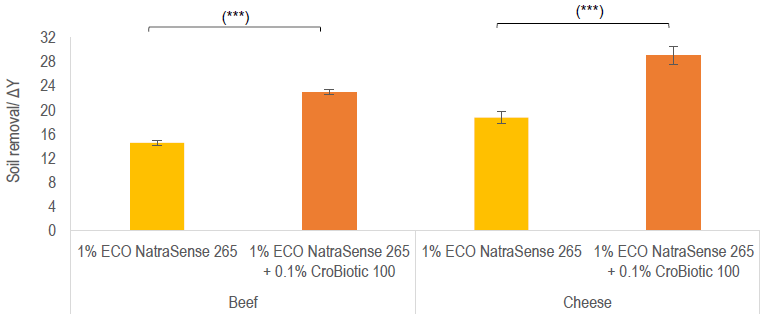
Figure 11: The visual analysis of soil removal measured after each wash by the change in color viewed using a spectrophotometer.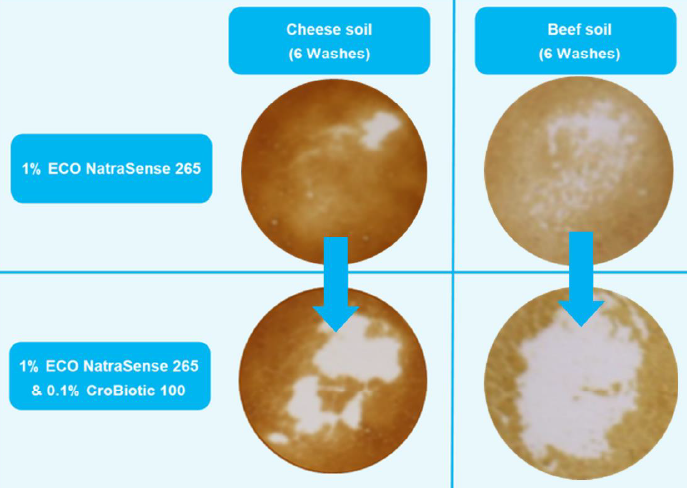
Visual representation of the removal of soil by CroBiotic™ 100 over repeated washes is shown in Figure 11.
Improved soil removal with reduced surfactant usageThe addition of probiotics into a cleaning formulation allows the surfactant usage to be reduced. As expected, we can see in Figure 12 that the higher the dosage of surfactant, the higher the level of soil removal. However, when using a low dosage of surfactant with CroBiotic™ 100, the cleaning performance is equivalent to a formulation with 8x more surfactant. This illustrates how CroBiotic™ 100 allows the surfactant level within formulations to be reduced, while still maintaining high levels of cleaning. The ability of CroBiotic™ 100 to provide effective cleaning with lower levels of traditional cleaning surfactants means that high performing formulations can be designed with lower carbon footprint and environmental impact vs. traditional formulations.
Removal of cheese soil after repeated cleaning with surfactant only and CroBiotic™ 100
Figure 12: Cheese soil removal after six cleaning cycles with surfactant only and with CroBiotic™ 100. The error bars represent +/- standard error. (**) p<0.01, (*) p<0.05, (n.s.) not significant.

Packaging & Availability
- Regional Availability

